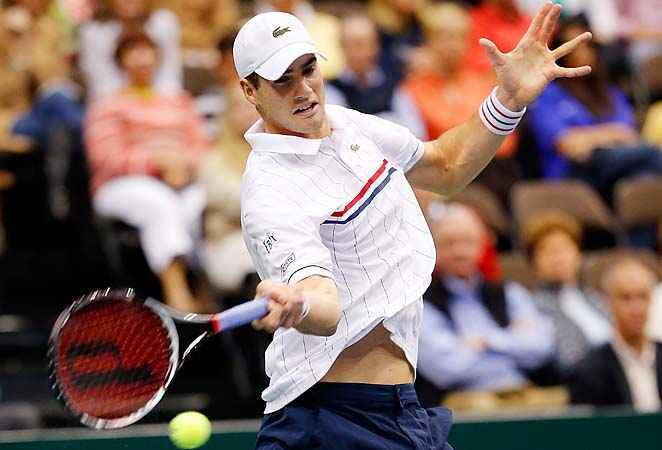No debate over No. 1 American, but Isner is a player in crisis

John Isner lost to Ryan Harrison in Sydney in his only ATP tournament match of 2013.
Sam Greenwood/Getty Images
So long a staple of tennis discussion, the argument has become sadly dated: Who's the best men's tennis player in America? Have we reached the point where no one really cares?
John Isner cares, quite deeply. As the No. 1 player on the U.S. Davis Cup team, he cherishes the responsibility and traditional implications. He's coming to the SAP Open in San Jose this week, and like many fans in the Bay Area, I'm anxious to get a first-hand look at a player in crisis. He has an excellent chance to win the tournament -- making its farewell appearance before moving to Brazil next year -- and such an accomplishment would do wonders for his shattered confidence.
During his storied four-year run at the University of Georgia, it's unlikely that Isner ever imagined carrying the hopes of his country. He was merely an excellent player, a solid team guy (and the school's all-time leader in singles and doubles wins). He wanted to experience the collegiate life before taking a run at professional tennis. Some of his friends even wondered if basketball was his best sport.
WERTHEIM: Making sense of Nadal's return
In recent months, we've witnessed the retirement of Andy Roddick and the debilitating health issues surrounding Mardy Fish. That shifted the focus entirely on Isner, the 6-foot-9 giant whose diligence and resolve had carried him into the world's top 10 (No. 9, last April). Currently standing 16th, he's still among the most feared players on tour, thanks to that booming service and big-finish forehand. But things have changed. Once known as the king of tiebreakers, and the man who survived (literally) that two-day marathon match against Nicolas Mahut at the 2010 Wimbledon, Isner now fights the stigma that he'll fold under the stress of an exhaustive, important match.
In each of last year's four majors, Isner reached the fifth set and lost -- before even sniffing the quarterfinals. He has a lifetime 5-10 record in five-setters, and after dropping one of those to Thomaz Bellucci under the stifling pressure of Davis Cup play against Brazil last weekend, he's lost three of his last four matches in that event. The straight-shooting Matt Cronin wrote on tennisreporters.net, "At this point, it's up to Isner to show that he's mentally stable enough to be the team's top dog. He's physically and technically capable of it, but he's not exactly oozing self-belief at this point."
One of Isner's most endearing qualities is his candor. Mention a weakness, a hint of vulnerability, and he's likely to be in complete agreement.
"You can't sugarcoat it with me," he said after the Bellucci match, refusing to blame a sore knee that had kept him out of the Australian Open. "My five-set record is atrocious, simple as that. It feels like there's a huge gorilla on my back, or something. It's wearing on me a bit, to be honest, mentally."
NGUYEN: Serena could grab No. 1 this week
He won't have any five-set concerns in San Jose, with its standard best-of-three tour-stop format, but he may have to face two-time defending champion Milos Raonic, another big-blast practitioner whose career, in contrast, is on the rise. The withdrawal of Alexandr Dolgopolov left the San Jose event decidedly short on finesse, and it now more resembles a forest of tall timber: Isner, Raonic, 6-6 Sam Querrey and 6-10 Ivo Karlovic. If you're looking for big first serves and short points, this is your tournament.
Consider, for a moment, how badly fans miss those age-old debates about the top-notch American. This is an argument dating all the way back to the 1920s, when big Bill Tilden engaged in a spirited rivalry with "Little Bill" Johnston (they ranked 1-2 in the world from 1920-23). Bobby Riggs, ranked No. 1 at the end of 1939, reached that plateau after years of competition against the great Don Budge.
Whatever the rankings may have said, there wasn't a more intriguing pair -- anywhere, any era -- than Jack Kramer and Pancho Gonzales in the late 1940s and early '50s, a competition destined for brevity due to the seven-year age difference. Ensuing years gave us Tony Trabert-Vic Seixas, Chuck McKinley-Dennis Ralston, and a matchup of Southern California collegiate legends, Arthur Ashe (UCLA) against Stan Smith (USC). The Jimmy Connors-John McEnroe rivalry transitioned nicely into Pete Sampras-Andre Agassi (with a dash of Jim Courier), before Roddick was left to his own devices against the forces of globalization.
It was Courier, just 14 months ago, who called Isner "probably the most disruptive force in the men's game. His serve is just a monster. No one from the top down likes to deal with it. He's not the best player in the world by any means, but he's probably the player that's least enjoyable to play."
That no longer seems to be the case. It's safe to say that two of the American players ranked below Isner in the top 100, Querrey (20) and Ryan Harrison (57), would love to get a shot at him in San Jose this week. Sounds like the perfect time. It's unlikely that Isner, with his prodigious talent and admirable character, will be down for long.
NGUYEN: Nadal gets B+ in Report Card





